Comprehensive Financial Analysis of Tate & Lyle PLC (2016-2020)
VerifiedAdded on 2022/12/28
|8
|1453
|80
Report
AI Summary
This report provides a comprehensive financial analysis of Tate & Lyle PLC, covering the period from 2016 to 2020. The analysis includes a review of the company's financial statements, specifically the balance sheet, income statement, and cash flow statement. The report delves into various financial ratios, categorizing them into profitability, solvency, and investment ratios. Profitability ratios such as Return on Net Capital Employed and Profit Margin are calculated and assessed. Solvency ratios, including Current Ratio and Quick Ratio, are examined to evaluate the company's ability to meet its short-term and long-term obligations. Investment ratios, such as Gearing Ratio and Earnings per Share, are also calculated and discussed to provide a holistic view of the company's financial performance. The report concludes with a summary of the key findings and their implications for the company's financial health and performance over the five-year period.
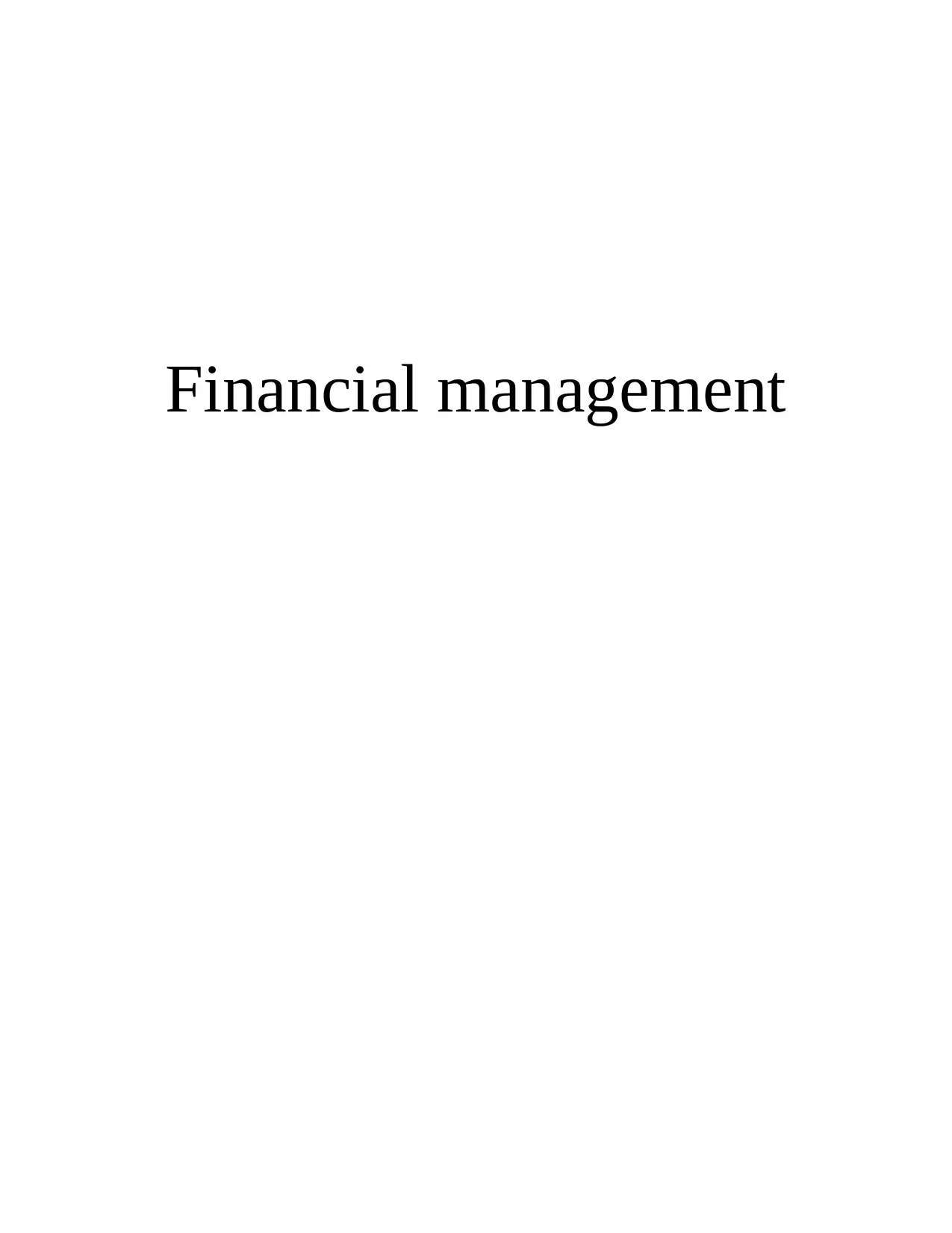
Financial management
Paraphrase This Document
Need a fresh take? Get an instant paraphrase of this document with our AI Paraphraser
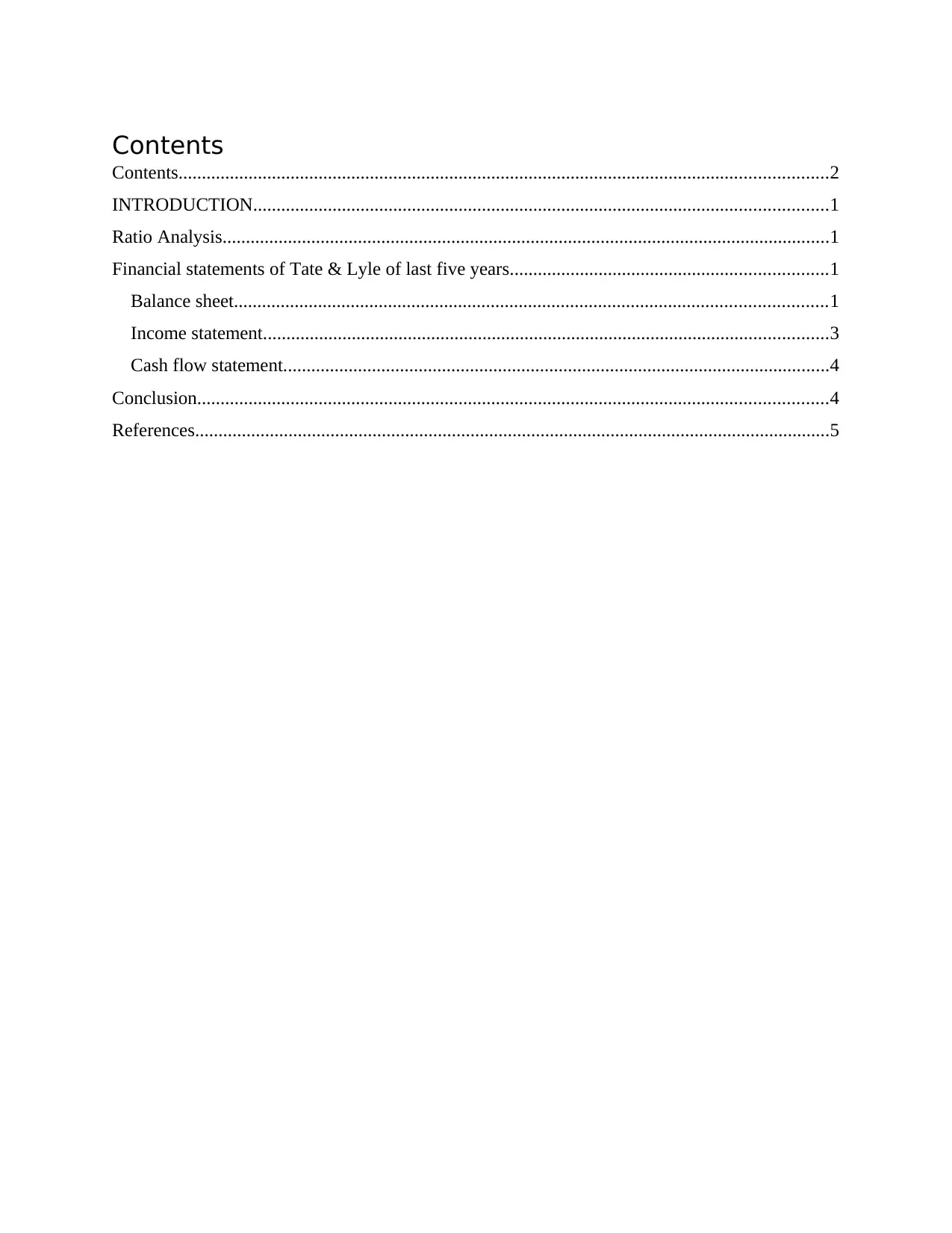
Contents
Contents...........................................................................................................................................2
INTRODUCTION...........................................................................................................................1
Ratio Analysis..................................................................................................................................1
Financial statements of Tate & Lyle of last five years....................................................................1
Balance sheet...............................................................................................................................1
Income statement.........................................................................................................................3
Cash flow statement.....................................................................................................................4
Conclusion.......................................................................................................................................4
References........................................................................................................................................5
Contents...........................................................................................................................................2
INTRODUCTION...........................................................................................................................1
Ratio Analysis..................................................................................................................................1
Financial statements of Tate & Lyle of last five years....................................................................1
Balance sheet...............................................................................................................................1
Income statement.........................................................................................................................3
Cash flow statement.....................................................................................................................4
Conclusion.......................................................................................................................................4
References........................................................................................................................................5
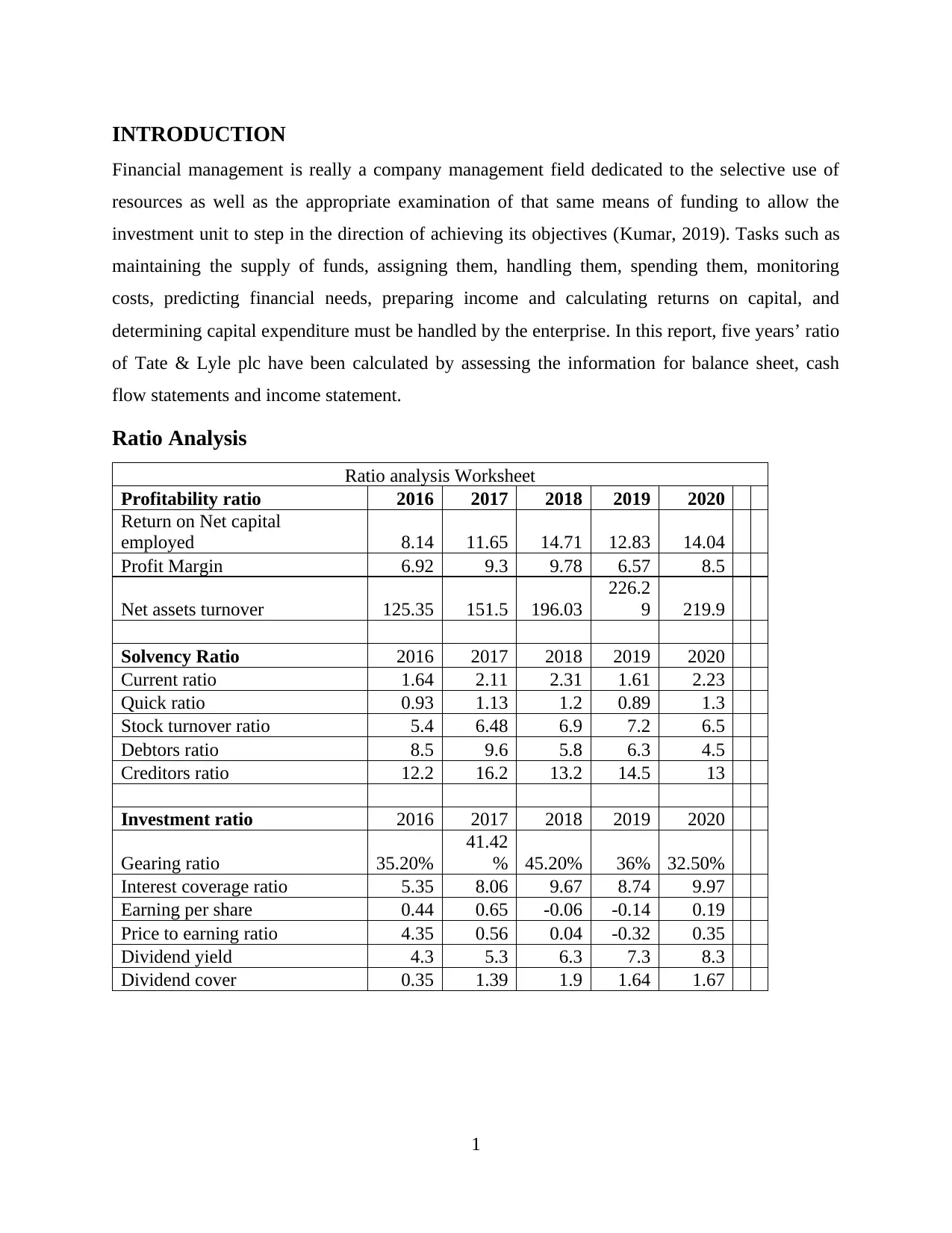
INTRODUCTION
Financial management is really a company management field dedicated to the selective use of
resources as well as the appropriate examination of that same means of funding to allow the
investment unit to step in the direction of achieving its objectives (Kumar, 2019). Tasks such as
maintaining the supply of funds, assigning them, handling them, spending them, monitoring
costs, predicting financial needs, preparing income and calculating returns on capital, and
determining capital expenditure must be handled by the enterprise. In this report, five years’ ratio
of Tate & Lyle plc have been calculated by assessing the information for balance sheet, cash
flow statements and income statement.
Ratio Analysis
Ratio analysis Worksheet
Profitability ratio 2016 2017 2018 2019 2020
Return on Net capital
employed 8.14 11.65 14.71 12.83 14.04
Profit Margin 6.92 9.3 9.78 6.57 8.5
Net assets turnover 125.35 151.5 196.03
226.2
9 219.9
Solvency Ratio 2016 2017 2018 2019 2020
Current ratio 1.64 2.11 2.31 1.61 2.23
Quick ratio 0.93 1.13 1.2 0.89 1.3
Stock turnover ratio 5.4 6.48 6.9 7.2 6.5
Debtors ratio 8.5 9.6 5.8 6.3 4.5
Creditors ratio 12.2 16.2 13.2 14.5 13
Investment ratio 2016 2017 2018 2019 2020
Gearing ratio 35.20%
41.42
% 45.20% 36% 32.50%
Interest coverage ratio 5.35 8.06 9.67 8.74 9.97
Earning per share 0.44 0.65 -0.06 -0.14 0.19
Price to earning ratio 4.35 0.56 0.04 -0.32 0.35
Dividend yield 4.3 5.3 6.3 7.3 8.3
Dividend cover 0.35 1.39 1.9 1.64 1.67
1
Financial management is really a company management field dedicated to the selective use of
resources as well as the appropriate examination of that same means of funding to allow the
investment unit to step in the direction of achieving its objectives (Kumar, 2019). Tasks such as
maintaining the supply of funds, assigning them, handling them, spending them, monitoring
costs, predicting financial needs, preparing income and calculating returns on capital, and
determining capital expenditure must be handled by the enterprise. In this report, five years’ ratio
of Tate & Lyle plc have been calculated by assessing the information for balance sheet, cash
flow statements and income statement.
Ratio Analysis
Ratio analysis Worksheet
Profitability ratio 2016 2017 2018 2019 2020
Return on Net capital
employed 8.14 11.65 14.71 12.83 14.04
Profit Margin 6.92 9.3 9.78 6.57 8.5
Net assets turnover 125.35 151.5 196.03
226.2
9 219.9
Solvency Ratio 2016 2017 2018 2019 2020
Current ratio 1.64 2.11 2.31 1.61 2.23
Quick ratio 0.93 1.13 1.2 0.89 1.3
Stock turnover ratio 5.4 6.48 6.9 7.2 6.5
Debtors ratio 8.5 9.6 5.8 6.3 4.5
Creditors ratio 12.2 16.2 13.2 14.5 13
Investment ratio 2016 2017 2018 2019 2020
Gearing ratio 35.20%
41.42
% 45.20% 36% 32.50%
Interest coverage ratio 5.35 8.06 9.67 8.74 9.97
Earning per share 0.44 0.65 -0.06 -0.14 0.19
Price to earning ratio 4.35 0.56 0.04 -0.32 0.35
Dividend yield 4.3 5.3 6.3 7.3 8.3
Dividend cover 0.35 1.39 1.9 1.64 1.67
1
⊘ This is a preview!⊘
Do you want full access?
Subscribe today to unlock all pages.

Trusted by 1+ million students worldwide
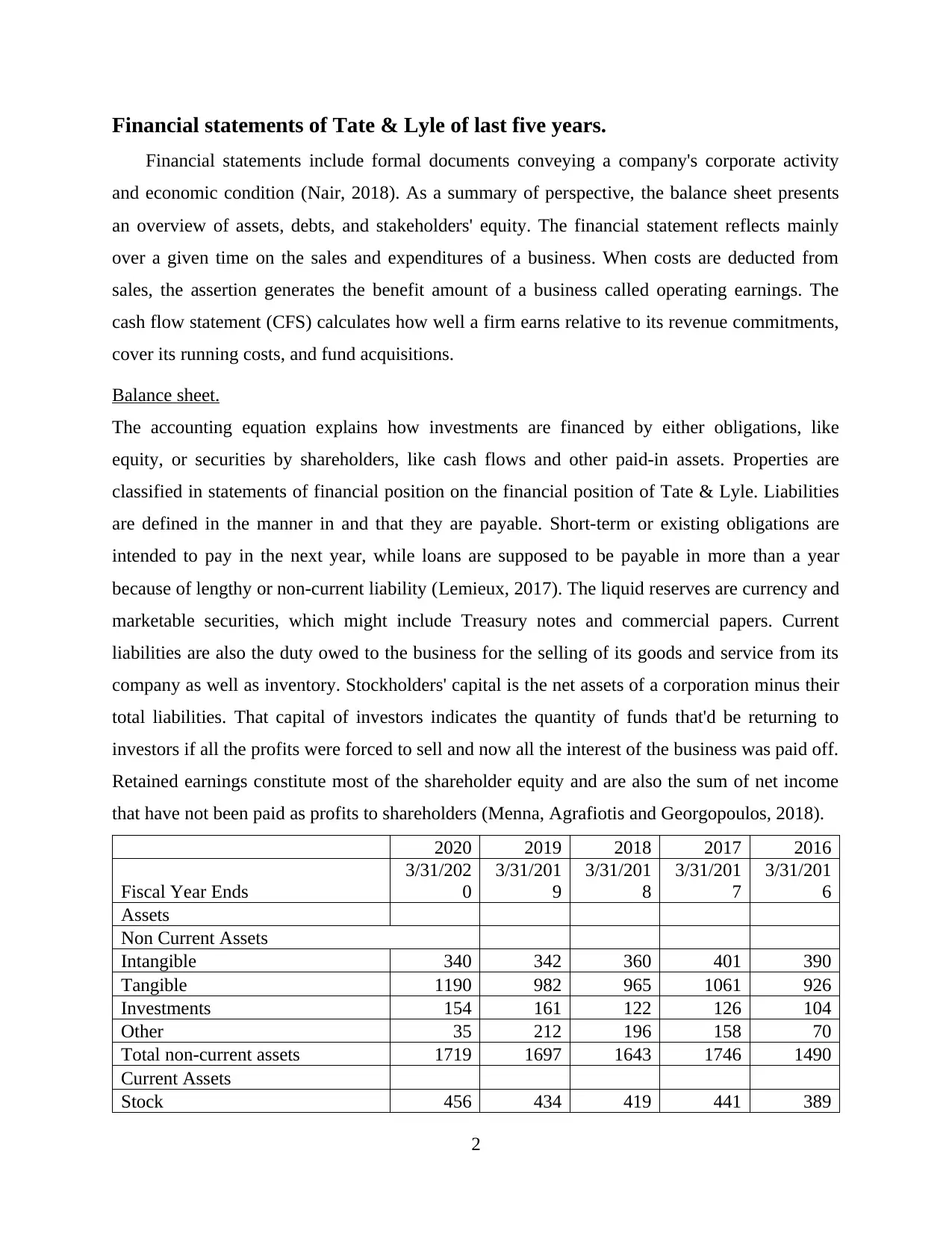
Financial statements of Tate & Lyle of last five years.
Financial statements include formal documents conveying a company's corporate activity
and economic condition (Nair, 2018). As a summary of perspective, the balance sheet presents
an overview of assets, debts, and stakeholders' equity. The financial statement reflects mainly
over a given time on the sales and expenditures of a business. When costs are deducted from
sales, the assertion generates the benefit amount of a business called operating earnings. The
cash flow statement (CFS) calculates how well a firm earns relative to its revenue commitments,
cover its running costs, and fund acquisitions.
Balance sheet.
The accounting equation explains how investments are financed by either obligations, like
equity, or securities by shareholders, like cash flows and other paid-in assets. Properties are
classified in statements of financial position on the financial position of Tate & Lyle. Liabilities
are defined in the manner in and that they are payable. Short-term or existing obligations are
intended to pay in the next year, while loans are supposed to be payable in more than a year
because of lengthy or non-current liability (Lemieux, 2017). The liquid reserves are currency and
marketable securities, which might include Treasury notes and commercial papers. Current
liabilities are also the duty owed to the business for the selling of its goods and service from its
company as well as inventory. Stockholders' capital is the net assets of a corporation minus their
total liabilities. That capital of investors indicates the quantity of funds that'd be returning to
investors if all the profits were forced to sell and now all the interest of the business was paid off.
Retained earnings constitute most of the shareholder equity and are also the sum of net income
that have not been paid as profits to shareholders (Menna, Agrafiotis and Georgopoulos, 2018).
2020 2019 2018 2017 2016
Fiscal Year Ends
3/31/202
0
3/31/201
9
3/31/201
8
3/31/201
7
3/31/201
6
Assets
Non Current Assets
Intangible 340 342 360 401 390
Tangible 1190 982 965 1061 926
Investments 154 161 122 126 104
Other 35 212 196 158 70
Total non-current assets 1719 1697 1643 1746 1490
Current Assets
Stock 456 434 419 441 389
2
Financial statements include formal documents conveying a company's corporate activity
and economic condition (Nair, 2018). As a summary of perspective, the balance sheet presents
an overview of assets, debts, and stakeholders' equity. The financial statement reflects mainly
over a given time on the sales and expenditures of a business. When costs are deducted from
sales, the assertion generates the benefit amount of a business called operating earnings. The
cash flow statement (CFS) calculates how well a firm earns relative to its revenue commitments,
cover its running costs, and fund acquisitions.
Balance sheet.
The accounting equation explains how investments are financed by either obligations, like
equity, or securities by shareholders, like cash flows and other paid-in assets. Properties are
classified in statements of financial position on the financial position of Tate & Lyle. Liabilities
are defined in the manner in and that they are payable. Short-term or existing obligations are
intended to pay in the next year, while loans are supposed to be payable in more than a year
because of lengthy or non-current liability (Lemieux, 2017). The liquid reserves are currency and
marketable securities, which might include Treasury notes and commercial papers. Current
liabilities are also the duty owed to the business for the selling of its goods and service from its
company as well as inventory. Stockholders' capital is the net assets of a corporation minus their
total liabilities. That capital of investors indicates the quantity of funds that'd be returning to
investors if all the profits were forced to sell and now all the interest of the business was paid off.
Retained earnings constitute most of the shareholder equity and are also the sum of net income
that have not been paid as profits to shareholders (Menna, Agrafiotis and Georgopoulos, 2018).
2020 2019 2018 2017 2016
Fiscal Year Ends
3/31/202
0
3/31/201
9
3/31/201
8
3/31/201
7
3/31/201
6
Assets
Non Current Assets
Intangible 340 342 360 401 390
Tangible 1190 982 965 1061 926
Investments 154 161 122 126 104
Other 35 212 196 158 70
Total non-current assets 1719 1697 1643 1746 1490
Current Assets
Stock 456 434 419 441 389
2
Paraphrase This Document
Need a fresh take? Get an instant paraphrase of this document with our AI Paraphraser

Debtors 321 319 293 288 286
Cash and Securities 338 285 190 261 321
Total current assets 1132 1096 928 1025 1057
Total Assets 2851 2793 2571 2771 2554
Liabilities and Equity
Liabilities
Current 508 681 402 487 650
Non-Current 944 623 802 952 875
Total Liabilities 1452 1304 1204 1439 1525
Equity
Share Capital 531 531 531 531 531
Reserves 868 958 836 801 497
Shareholders Funds
Minorities 1
Total Equity 1399 1489 1367 1332 1029
Total Liabilities and Equity 2851 2793 2571 2771 2554
Net Borrowings 449 310 378 429 437
Investment Ratios
Net Tangible Asset Value Per
Share 219.9 226.29 196.03 151.5 126.65
ROCE 14.042 12.831 14.707 11.646 8.141
Return on Equity
Net Gearing
Gross Gearing
Cash 19.371 19.14 13.899 19.595 30.837
InterestCoverAbbr 9.97 8.742 9.667 8.061 5.345
QuickRatioAbbr 1.297 0.887 1.201 1.127 0.934
CurrentRatioAbbr 2.228 1.609 2.308 2.105 1.637
Borrowings
Total Borrowings 720 595 568 690 754
Income statement.
2020 2019 2018 2017 2016
Fiscal Year Ends
3/31/202
0 3/31/2019
3/31/201
8 3/31/2017 3/31/2016
Turnover 2882 2755 2710 2753 2355
Expenses 2560 2459 2425 2491 2178
EBITDA 501 423 473 415 270
EBIT 329 271 319 266 155
Operating Profit
(reported) 322 296 285 262 177
Operating Profit (adjusted)
3
Cash and Securities 338 285 190 261 321
Total current assets 1132 1096 928 1025 1057
Total Assets 2851 2793 2571 2771 2554
Liabilities and Equity
Liabilities
Current 508 681 402 487 650
Non-Current 944 623 802 952 875
Total Liabilities 1452 1304 1204 1439 1525
Equity
Share Capital 531 531 531 531 531
Reserves 868 958 836 801 497
Shareholders Funds
Minorities 1
Total Equity 1399 1489 1367 1332 1029
Total Liabilities and Equity 2851 2793 2571 2771 2554
Net Borrowings 449 310 378 429 437
Investment Ratios
Net Tangible Asset Value Per
Share 219.9 226.29 196.03 151.5 126.65
ROCE 14.042 12.831 14.707 11.646 8.141
Return on Equity
Net Gearing
Gross Gearing
Cash 19.371 19.14 13.899 19.595 30.837
InterestCoverAbbr 9.97 8.742 9.667 8.061 5.345
QuickRatioAbbr 1.297 0.887 1.201 1.127 0.934
CurrentRatioAbbr 2.228 1.609 2.308 2.105 1.637
Borrowings
Total Borrowings 720 595 568 690 754
Income statement.
2020 2019 2018 2017 2016
Fiscal Year Ends
3/31/202
0 3/31/2019
3/31/201
8 3/31/2017 3/31/2016
Turnover 2882 2755 2710 2753 2355
Expenses 2560 2459 2425 2491 2178
EBITDA 501 423 473 415 270
EBIT 329 271 319 266 155
Operating Profit
(reported) 322 296 285 262 177
Operating Profit (adjusted)
3
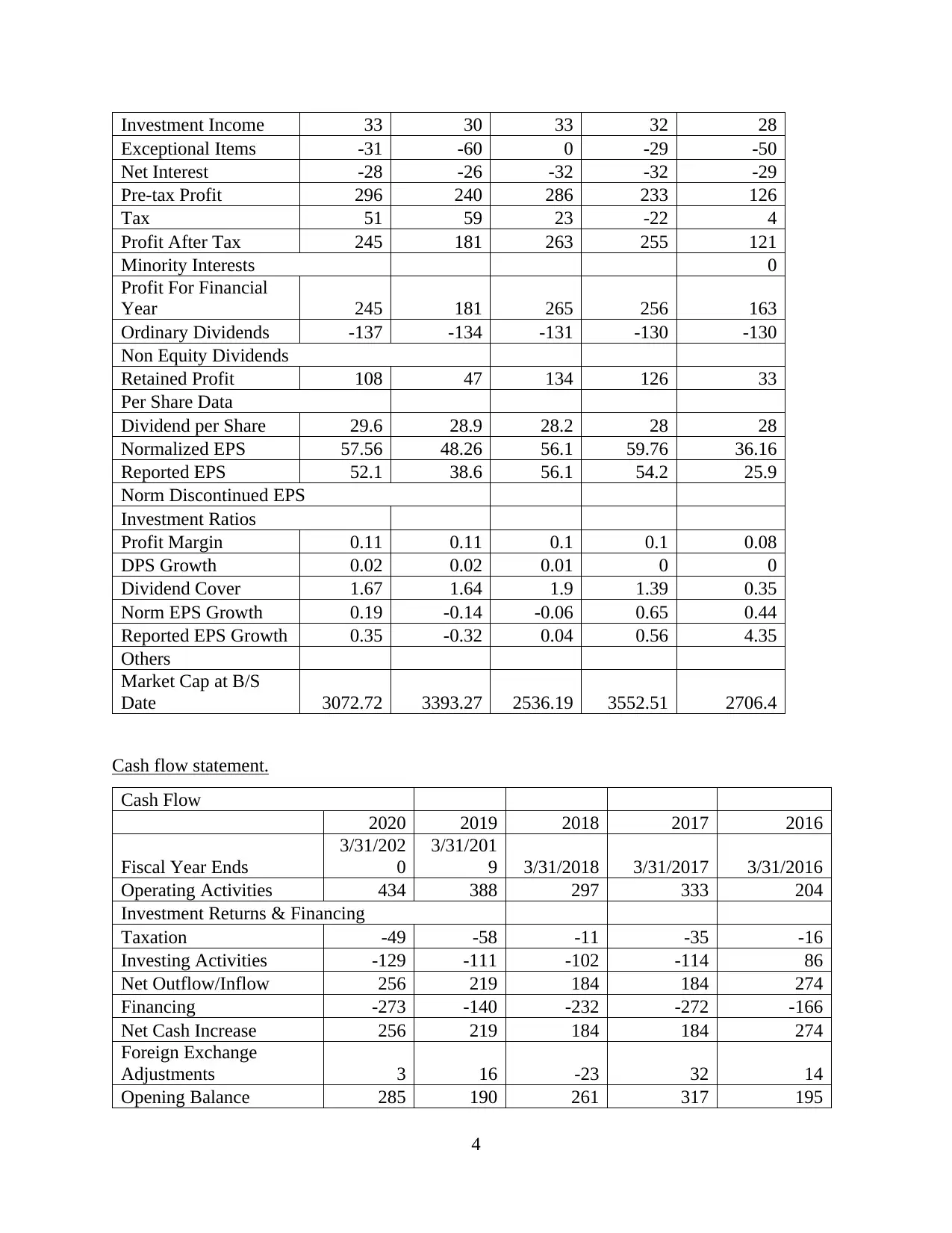
Investment Income 33 30 33 32 28
Exceptional Items -31 -60 0 -29 -50
Net Interest -28 -26 -32 -32 -29
Pre-tax Profit 296 240 286 233 126
Tax 51 59 23 -22 4
Profit After Tax 245 181 263 255 121
Minority Interests 0
Profit For Financial
Year 245 181 265 256 163
Ordinary Dividends -137 -134 -131 -130 -130
Non Equity Dividends
Retained Profit 108 47 134 126 33
Per Share Data
Dividend per Share 29.6 28.9 28.2 28 28
Normalized EPS 57.56 48.26 56.1 59.76 36.16
Reported EPS 52.1 38.6 56.1 54.2 25.9
Norm Discontinued EPS
Investment Ratios
Profit Margin 0.11 0.11 0.1 0.1 0.08
DPS Growth 0.02 0.02 0.01 0 0
Dividend Cover 1.67 1.64 1.9 1.39 0.35
Norm EPS Growth 0.19 -0.14 -0.06 0.65 0.44
Reported EPS Growth 0.35 -0.32 0.04 0.56 4.35
Others
Market Cap at B/S
Date 3072.72 3393.27 2536.19 3552.51 2706.4
Cash flow statement.
Cash Flow
2020 2019 2018 2017 2016
Fiscal Year Ends
3/31/202
0
3/31/201
9 3/31/2018 3/31/2017 3/31/2016
Operating Activities 434 388 297 333 204
Investment Returns & Financing
Taxation -49 -58 -11 -35 -16
Investing Activities -129 -111 -102 -114 86
Net Outflow/Inflow 256 219 184 184 274
Financing -273 -140 -232 -272 -166
Net Cash Increase 256 219 184 184 274
Foreign Exchange
Adjustments 3 16 -23 32 14
Opening Balance 285 190 261 317 195
4
Exceptional Items -31 -60 0 -29 -50
Net Interest -28 -26 -32 -32 -29
Pre-tax Profit 296 240 286 233 126
Tax 51 59 23 -22 4
Profit After Tax 245 181 263 255 121
Minority Interests 0
Profit For Financial
Year 245 181 265 256 163
Ordinary Dividends -137 -134 -131 -130 -130
Non Equity Dividends
Retained Profit 108 47 134 126 33
Per Share Data
Dividend per Share 29.6 28.9 28.2 28 28
Normalized EPS 57.56 48.26 56.1 59.76 36.16
Reported EPS 52.1 38.6 56.1 54.2 25.9
Norm Discontinued EPS
Investment Ratios
Profit Margin 0.11 0.11 0.1 0.1 0.08
DPS Growth 0.02 0.02 0.01 0 0
Dividend Cover 1.67 1.64 1.9 1.39 0.35
Norm EPS Growth 0.19 -0.14 -0.06 0.65 0.44
Reported EPS Growth 0.35 -0.32 0.04 0.56 4.35
Others
Market Cap at B/S
Date 3072.72 3393.27 2536.19 3552.51 2706.4
Cash flow statement.
Cash Flow
2020 2019 2018 2017 2016
Fiscal Year Ends
3/31/202
0
3/31/201
9 3/31/2018 3/31/2017 3/31/2016
Operating Activities 434 388 297 333 204
Investment Returns & Financing
Taxation -49 -58 -11 -35 -16
Investing Activities -129 -111 -102 -114 86
Net Outflow/Inflow 256 219 184 184 274
Financing -273 -140 -232 -272 -166
Net Cash Increase 256 219 184 184 274
Foreign Exchange
Adjustments 3 16 -23 32 14
Opening Balance 285 190 261 317 195
4
⊘ This is a preview!⊘
Do you want full access?
Subscribe today to unlock all pages.

Trusted by 1+ million students worldwide
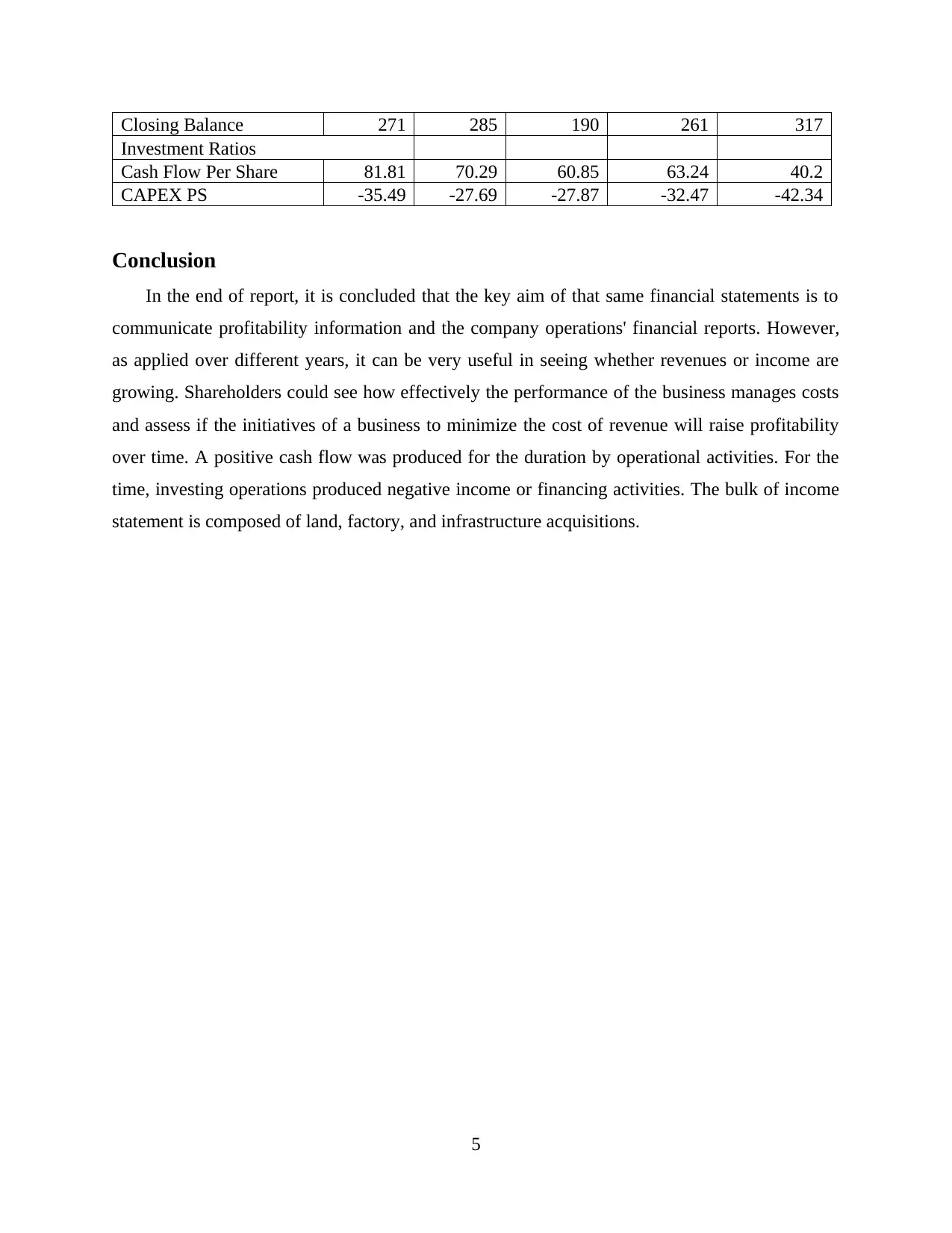
Closing Balance 271 285 190 261 317
Investment Ratios
Cash Flow Per Share 81.81 70.29 60.85 63.24 40.2
CAPEX PS -35.49 -27.69 -27.87 -32.47 -42.34
Conclusion
In the end of report, it is concluded that the key aim of that same financial statements is to
communicate profitability information and the company operations' financial reports. However,
as applied over different years, it can be very useful in seeing whether revenues or income are
growing. Shareholders could see how effectively the performance of the business manages costs
and assess if the initiatives of a business to minimize the cost of revenue will raise profitability
over time. A positive cash flow was produced for the duration by operational activities. For the
time, investing operations produced negative income or financing activities. The bulk of income
statement is composed of land, factory, and infrastructure acquisitions.
5
Investment Ratios
Cash Flow Per Share 81.81 70.29 60.85 63.24 40.2
CAPEX PS -35.49 -27.69 -27.87 -32.47 -42.34
Conclusion
In the end of report, it is concluded that the key aim of that same financial statements is to
communicate profitability information and the company operations' financial reports. However,
as applied over different years, it can be very useful in seeing whether revenues or income are
growing. Shareholders could see how effectively the performance of the business manages costs
and assess if the initiatives of a business to minimize the cost of revenue will raise profitability
over time. A positive cash flow was produced for the duration by operational activities. For the
time, investing operations produced negative income or financing activities. The bulk of income
statement is composed of land, factory, and infrastructure acquisitions.
5
Paraphrase This Document
Need a fresh take? Get an instant paraphrase of this document with our AI Paraphraser
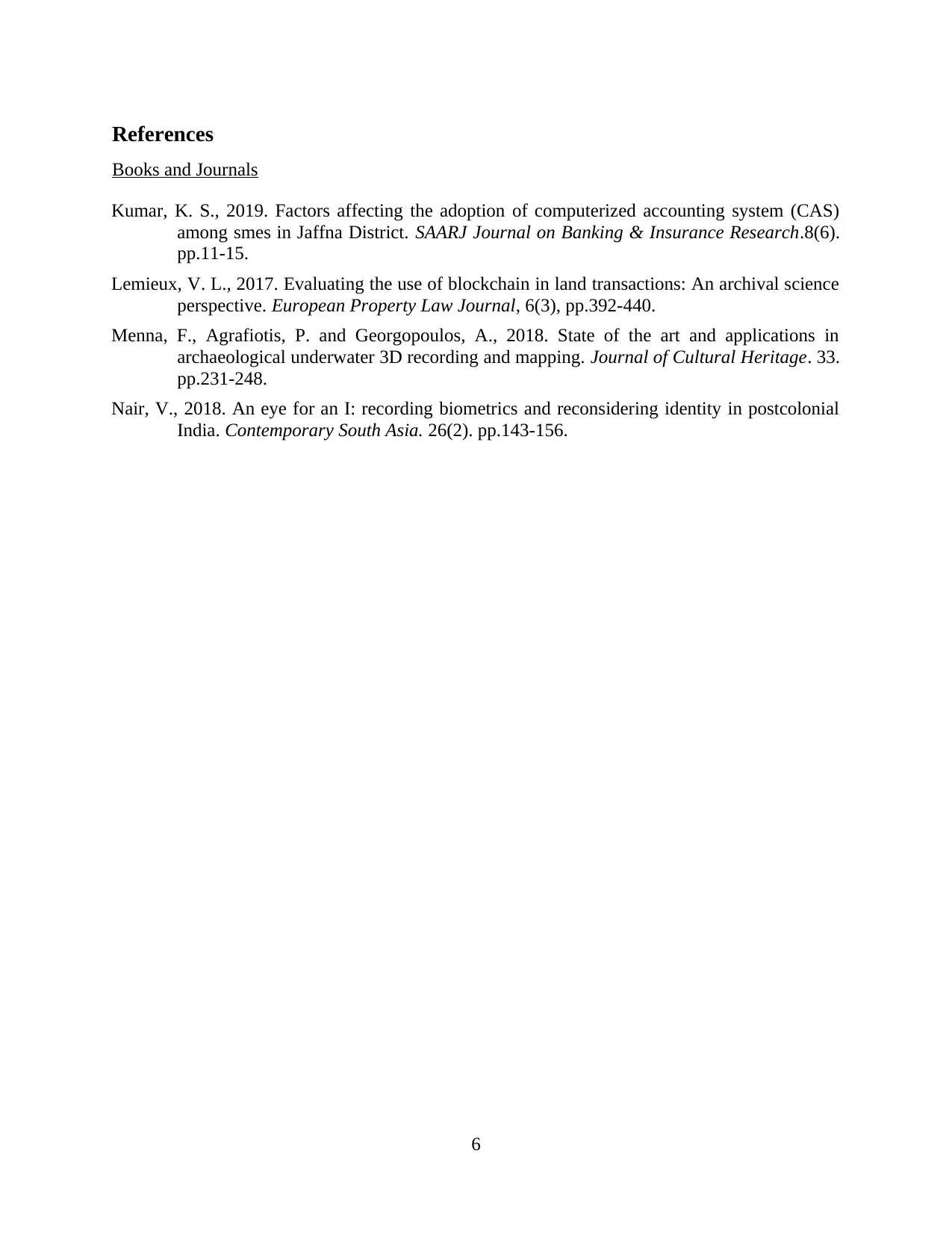
References
Books and Journals
Kumar, K. S., 2019. Factors affecting the adoption of computerized accounting system (CAS)
among smes in Jaffna District. SAARJ Journal on Banking & Insurance Research.8(6).
pp.11-15.
Lemieux, V. L., 2017. Evaluating the use of blockchain in land transactions: An archival science
perspective. European Property Law Journal, 6(3), pp.392-440.
Menna, F., Agrafiotis, P. and Georgopoulos, A., 2018. State of the art and applications in
archaeological underwater 3D recording and mapping. Journal of Cultural Heritage. 33.
pp.231-248.
Nair, V., 2018. An eye for an I: recording biometrics and reconsidering identity in postcolonial
India. Contemporary South Asia. 26(2). pp.143-156.
6
Books and Journals
Kumar, K. S., 2019. Factors affecting the adoption of computerized accounting system (CAS)
among smes in Jaffna District. SAARJ Journal on Banking & Insurance Research.8(6).
pp.11-15.
Lemieux, V. L., 2017. Evaluating the use of blockchain in land transactions: An archival science
perspective. European Property Law Journal, 6(3), pp.392-440.
Menna, F., Agrafiotis, P. and Georgopoulos, A., 2018. State of the art and applications in
archaeological underwater 3D recording and mapping. Journal of Cultural Heritage. 33.
pp.231-248.
Nair, V., 2018. An eye for an I: recording biometrics and reconsidering identity in postcolonial
India. Contemporary South Asia. 26(2). pp.143-156.
6
1 out of 8
Related Documents
Your All-in-One AI-Powered Toolkit for Academic Success.
+13062052269
info@desklib.com
Available 24*7 on WhatsApp / Email
![[object Object]](/_next/static/media/star-bottom.7253800d.svg)
Unlock your academic potential
Copyright © 2020–2026 A2Z Services. All Rights Reserved. Developed and managed by ZUCOL.





